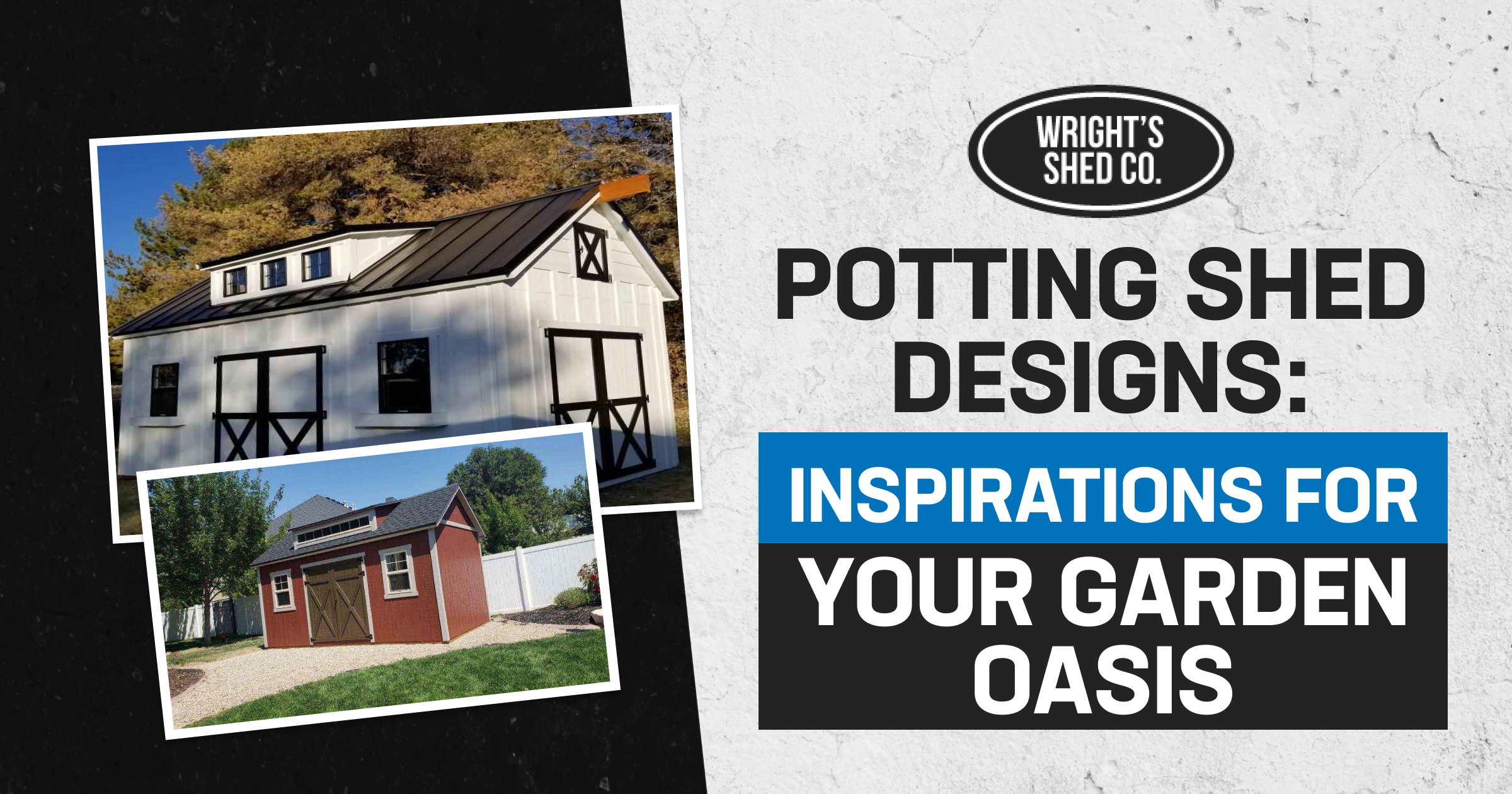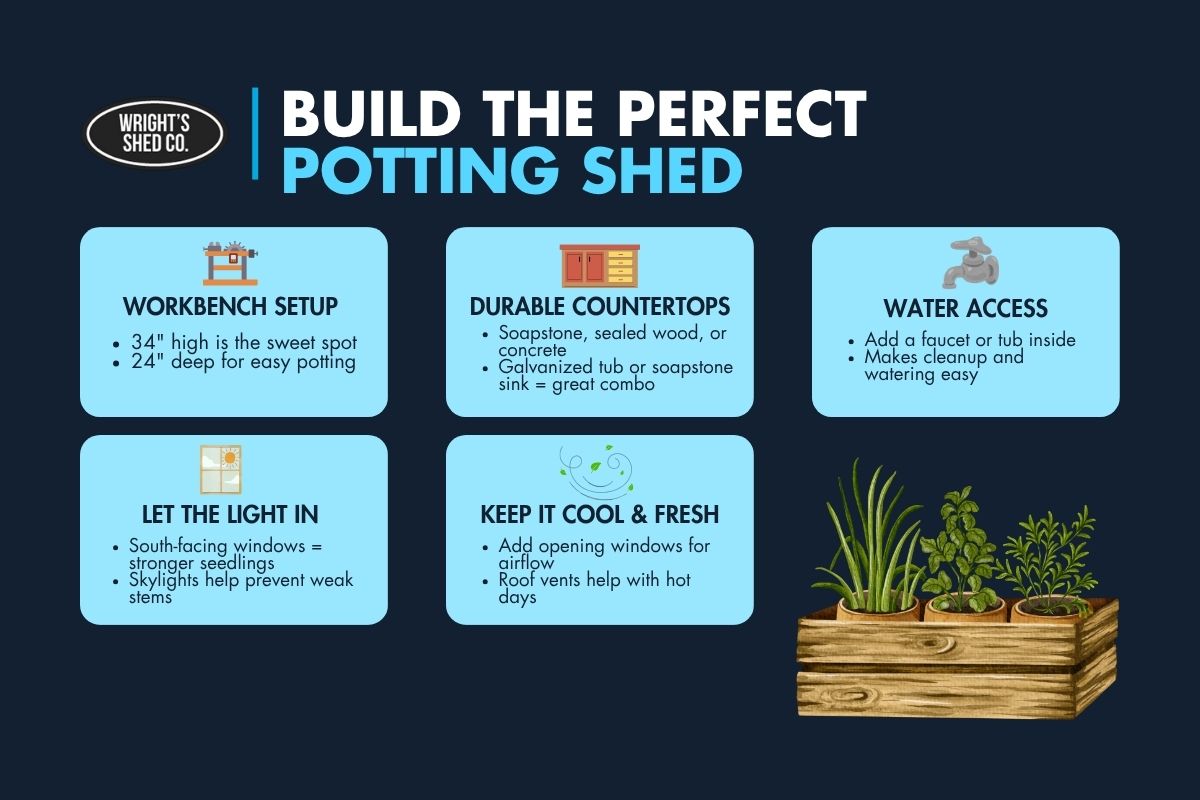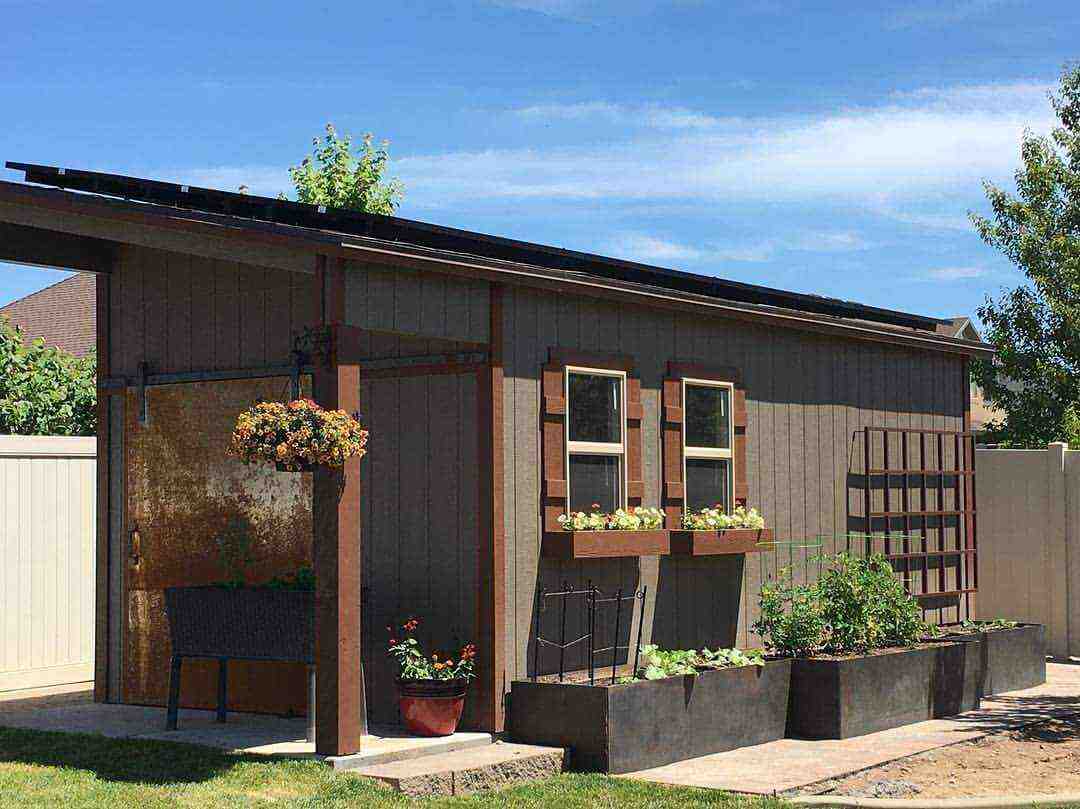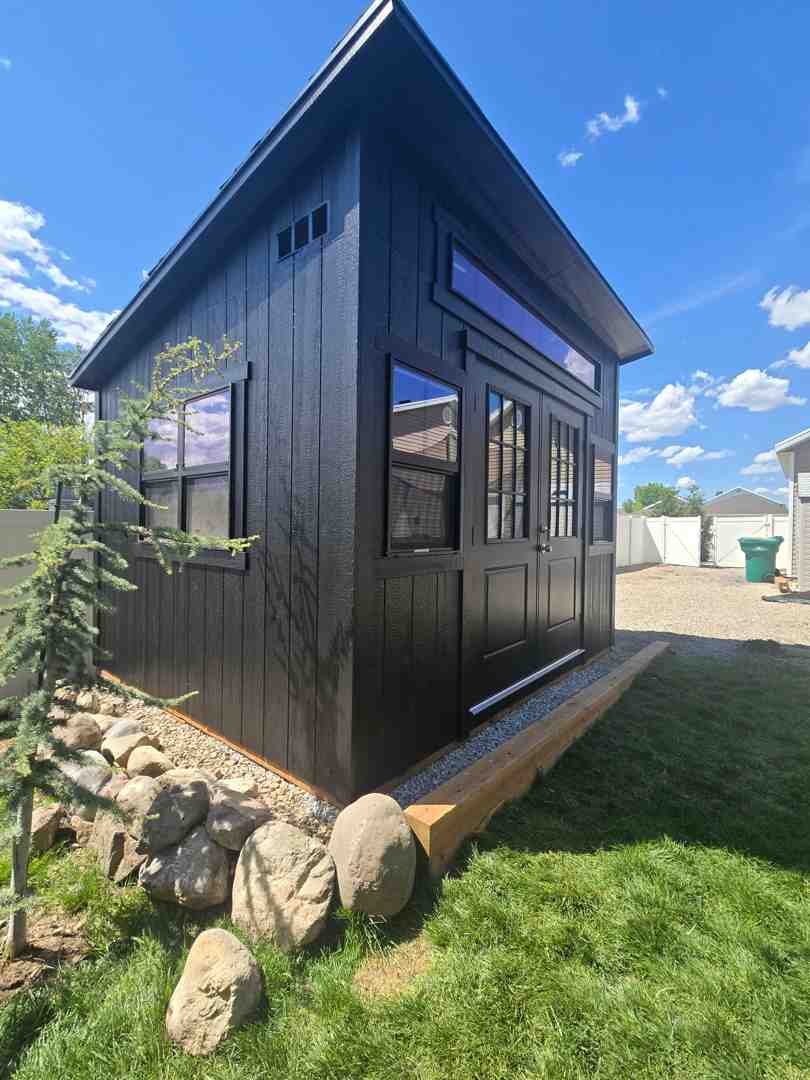Why Potting Shed Designs Are Changing Modern Gardens
Potting shed designs have evolved far beyond simple storage spaces into functional garden sanctuaries that blend beauty with purpose. Here are the most popular design approaches:
Traditional & Rustic Styles:
- Farmhouse aesthetic with weathered wood siding.
- Dutch doors and vintage hardware.
- Reclaimed materials for authentic character.
Modern & Greenhouse Hybrids:
- Clean lines with dark paint colors.
- Large glass panels and polycarbonate roofing.
- Lean-to designs attached to existing structures.
Essential Features:
- Natural light through south-facing windows.
- Durable work surfaces (soapstone or concrete).
- Adequate ventilation and water access.
- Smart storage solutions with vertical space.
The global potting shed market has grown to $1.2 billion and is projected to reach $1.9 billion by 2030, driven by the surge in home gardening and outdoor living spaces. What started as purely functional storage has transformed into what one gardener described as their “sanctuary” – a place where I can just relax…and breathe.
Modern potting sheds serve multiple roles: plant propagation centers, tool storage hubs, and creative retreats. Whether you’re drawn to a cottage-style shed with vintage finds or a sleek greenhouse hybrid with metal roofing, the key is matching your design to both your gardening needs and property aesthetic.
The Anatomy of a Functional Potting Shed
Creating the perfect potting shed designs starts with understanding what makes a space truly functional. Think of it as designing a kitchen for your garden, every element needs to work together seamlessly to support your gardening passion.
The potting bench serves as your garden command center. After building countless sheds over the years, I’ve learned that getting the height right makes all the difference. A workbench at 34 inches high with about two feet of depth gives you that sweet spot where you can work comfortably without straining your back during those marathon potting sessions.
Your countertop choice matters more than you might think. Durable countertops like soapstone, concrete, or even well-sealed wood can handle the daily splash of water and soil that comes with serious gardening. Soapstone sinks have become incredibly popular with our customers, they’re naturally stain-resistant and develop a beautiful patina over time. Galvanized tubs offer another charming option that’s both practical and budget-friendly.
Having water access right where you need it transforms your shed from good to great. Whether it’s washing muddy tools, rinsing pots, or giving seedlings a gentle drink, that convenient water source saves countless trips back to the house.
Natural light optimization can make or break your potting shed experience. South-facing windows capture the maximum amount of sunlight throughout the day, which your seedlings absolutely crave. Adding skylights floods the space with even more light and prevents young plants from stretching toward a single light source, something that creates those spindly, weak stems gardeners dread.
Don’t underestimate the power of ventilation. Operable windows positioned strategically allow fresh air to circulate, preventing that stuffy greenhouse effect that can harm both plants and your comfort. Adding vents near the roof line creates natural air flow that keeps temperatures manageable even on hot summer days.
A well-designed potting shed becomes your personal Shed Retreat for Year-Round Comfort.
Key Considerations for Your Potting Shed Designs
Beyond the essentials, several thoughtful additions can lift your potting shed from functional to fantastic.
Flooring options deserve careful consideration since you’ll be dealing with water and soil daily. Brick floors offer timeless charm and excellent drainage, perfect for those inevitable spills. Concrete floors provide durability and easy cleanup, though they can feel cold underfoot. Wood flooring creates warmth and beauty but requires more maintenance in this moisture-rich environment.
Electrical access opens up a world of possibilities. Imagine plugging in grow lights for seedlings, charging your favorite cordless tools, or running a small radio to keep you company during quiet potting sessions. It’s one of those upgrades that seems small but makes a huge impact on daily use.
For heating options, nothing beats the cozy atmosphere of a wood-burning stove on chilly mornings. The gentle warmth lets you start your gardening day early, even when frost still covers the ground. Space heaters provide a more practical solution for most gardeners, offering reliable warmth without the commitment of installing a chimney.
The key to great potting shed designs lies in balancing all these elements to match your specific gardening style and climate needs. Choosing the Perfect Design for Your Backyard can help you steer these decisions and create a space that truly serves your gardening dreams.
Exploring Popular Potting Shed Designs and Styles
The beauty of potting shed designs lies in their incredible versatility. Whether you’re dreaming of a charming cottage-style retreat or a sleek modern workspace, there’s a design that’ll perfectly match your garden’s personality and your practical needs.
When choosing your materials, it helps to understand what you’re getting into. Wood gives you that natural beauty and can be customized to your heart’s content, but it’ll need regular maintenance like painting or staining. Metal is your low-maintenance champion – it won’t rot or attract pests, though it can get pretty toasty in summer heat. Reclaimed materials offer unique character and help your budget, but sourcing quality pieces can be a treasure hunt in itself.
For structures that’ll stand the test of time, exploring Low Maintenance Sheds: Durable Materials gives you the full picture of what works best in different situations.
Traditional and Rustic Styles
There’s something magical about a cottage-style potting shed that feels like it’s been part of your garden forever. These designs accept the farmhouse aesthetic with weathered wood siding that tells a story of seasons past. We love working with reclaimed wood because it brings instant character – the kind of authentic, lived-in feel that new lumber just can’t match.
Dutch doors are the crown jewel of traditional designs. Picture this: you’re transplanting seedlings on a perfect spring morning, and you can swing open just the top half of your door. Fresh air flows through while keeping curious pets or unwanted visitors at bay. It’s practical charm at its finest.
The weathered look doesn’t happen by accident – it’s about choosing materials and finishes that age gracefully. Vintage hardware adds those perfect finishing touches that make your shed feel like a treasured family heirloom. You can see an example of a rustic shed that captures this timeless appeal beautifully.
These traditional designs blend seamlessly into established gardens, becoming a natural extension of your outdoor space rather than an afterthought.
Modern and Greenhouse-Hybrid Styles
If your taste runs more contemporary, modern potting shed designs offer clean lines and bold statements that can transform your backyard into a design showcase. Dark paint colors – especially striking blacks – create dramatic focal points that look incredible against green landscapes. Pair that with sleek metal roofs and you’ve got a shed that’s as much about style as function.
The real game-changer in modern designs is the integration of polycarbonate panels and glass walls. These materials flood your workspace with natural light while creating that coveted greenhouse effect. A lean-to style attached to your house or garage maximizes space efficiency while maintaining that contemporary aesthetic.
Here’s where things get really interesting: the half-shed half-greenhouse concept. While we can’t offer this as a standard design, it’s brilliant inspiration for custom builds. Imagine having your potting bench right next to your seedling area – no more carrying trays back and forth between separate structures. It creates a seamless workflow that serious gardeners absolutely love.
The beauty of modern designs is how they accept both form and function. Large windows and glass panels don’t just look stunning – they provide the perfect environment for nurturing plants year-round. Check out our 3 Shed Styles to Consider for more contemporary inspiration.
Common Materials and Their Benefits
Let’s talk about what actually goes into building these beautiful spaces. Wood siding, particularly cedar, remains a favorite because it naturally resists rot and insects while aging into gorgeous silver-gray tones. Shiplap siding takes things up a notch with its overlapping design that keeps weather out while adding classic visual appeal.
Reclaimed materials are where creativity really shines. Salvaged windows and doors don’t just save money – they add character that you simply can’t buy new. I’ve seen award-winning sheds built almost entirely from repurposed materials, and they have personality that mass-produced buildings never achieve.
For roofing, metal roofing delivers decades of low-maintenance performance in colors that complement any design style. Polycarbonate roofing is fantastic for greenhouse sections – it’s lightweight, won’t shatter like glass, and transmits light beautifully while providing excellent insulation.
At Wright’s Shed Co., we’ve been perfecting our material choices since 1997. Our sheds come with upgraded features as standard because we believe in building structures that last. When we offer warranties, that’s not just confidence – it’s proof that quality materials make all the difference. Explore our complete range of Shed Designs and Plans to see how the right materials create lasting value.
From Clutter to Creative Haven: Storage & Personalization
Your potting shed designs can be absolutely gorgeous, but if you can’t find your favorite trowel when you need it, all that beauty won’t matter much. The difference between a frustrating workspace and a true garden sanctuary often comes down to smart storage and thoughtful organization.
I’ve learned over the years that a well-organized shed isn’t just about looking neat, it’s about creating a space where you actually want to spend time. When everything has its place, you can focus on what you love most: nurturing your plants and enjoying the peaceful rhythm of garden work. That’s why we always encourage exploring Shed Organization Hacks to help you make the most of every square inch.
Smart Storage and Organization Solutions
The secret to changing any potting shed from cluttered storage to organized workspace lies in thinking vertically. Your walls are valuable real estate that shouldn’t go to waste.
Pegboards are absolute game-changers for keeping small tools visible and within arm’s reach. There’s something deeply satisfying about having every tool outlined on a pegboard, you’ll know instantly when something’s missing. Wall-mounted racks handle the bigger players like shovels, rakes, and hoes beautifully. One of my favorite clever hacks involves repurposing old steel garden rakes as wall-mounted tool organizers. Just flip them upside down and mount them to the wall, the tines become perfect hooks with built-in rustic charm.
Magnetic tool bars work wonderfully for smaller metal items like pruners, trowels, and plant markers. They keep these frequently-used tools right at eye level where you can grab them quickly. For everything else, strategic shelving with different depths accommodates various sized pots, seed packets, and gardening supplies.
Under-bench storage is often overlooked gold mine space. This area is perfect for storing bags of potting mix, empty containers, or seasonal items that don’t need daily access. Bins and labels might seem overly organized, but they’re lifesavers when you’re looking for specific plant tags, specialty fertilizers, or that perfect pair of pruning gloves.
Here are five storage solutions that work exceptionally well in compact spaces: vertical pegboard systems that get tools off surfaces, tiered shelving that maximizes height for pot storage, hanging baskets for small supplies like twine and plant ties, pull-out drawers beneath work surfaces for hidden bulk storage, and door-mounted organizers that turn the back of your shed door into useful space for aprons and frequently-used hand tools.
You can Find organization systems here that integrate seamlessly with Wright’s Shed Co. structures.
Making It a Comfortable and Inspiring Workspace
Organization gets you functional, but personal touches transform your potting shed into a space that truly inspires creativity and brings joy to your gardening routine.
Vintage finds add character that can’t be bought new. An old galvanized watering can, weathered enamelware, or antique garden signs tell stories and create conversation starters. These pieces don’t just look good, they connect you to generations of gardeners who came before.
Comfortable seating might seem like a luxury, but it’s really a necessity. A small bench or even a simple stool gives you a place to rest between tasks, flip through seed catalogs, or just sit quietly and plan your next garden project. Good lighting makes detailed work like seed starting or plant propagation much easier on your eyes.
Don’t be afraid of paint colors that reflect your personality. A cheerful sage green or warm cream on interior walls can completely change the feel of your space. Some gardeners even hand-paint decorative elements on floors or walls for a truly custom touch.
The most successful potting sheds I’ve seen serve as multi-functional spaces. They might include a small reading corner with gardening books, a craft area for making plant markers, or even a cozy spot with a small table for morning coffee while you plan your day’s garden tasks. Your potting shed can become your personal retreat, a place where the outside world fades away and you can focus entirely on the satisfying work of growing things.
Adapting Your Shed for Different Climates
Building across Utah, Idaho, Iowa, and Nebraska has taught me that climate isn’t just a consideration – it’s the foundation of good design. Your shed needs to work beautifully in your specific environment, whether you’re dealing with harsh mountain winters or scorching prairie summers.
In cold climates, your potting shed can become a true four-season retreat with proper planning. Insulation transforms a basic shed into a comfortable workspace where you can start seeds in February while snow swirls outside. We often recommend spray foam insulation for the best thermal barrier, though there are budget-friendly options too. Our guide on How to Insulate a Shed on a Budget covers several approaches that work well.
Heating options range from simple to sophisticated. A small wood-burning stove creates incredible ambiance – there’s nothing quite like the crackle of a fire while you’re planning next year’s garden. For convenience, electric space heaters work wonderfully and don’t require chimney installation.
Hot climate design requires a completely different approach. Here, ventilation becomes your best friend. Shade is crucial – strategic roof overhangs not only protect the interior but create covered outdoor workspace for those tasks that are just too messy to do inside.
Siting your shed properly makes an enormous difference. In hot climates, morning sun with afternoon shade is ideal. In cold regions, southern exposure maximizes winter warmth. These details might seem small, but they determine whether your shed becomes your favorite retreat or an uncomfortable afterthought.
Frequently Asked Questions about Potting Shed Designs
After building custom outdoor structures for over 25 years, I’ve heard just about every question you can imagine about potting shed designs. Let me share the answers to the most common ones that come up during our consultations.
What is the best size for a potting shed?
The perfect size really comes down to how you plan to use your space. Most of our customers find that 8×10 feet or 10×12 feet gives them the sweet spot between functionality and fitting nicely in their backyard.
Here’s a practical tip I always share: before you decide on dimensions, lay out all your tools and equipment on your garage floor or driveway. Include everything – your wheelbarrow, bags of potting soil, watering cans, and that collection of terra cotta pots you’ve been accumulating. This exercise gives you a real sense of the floor space you’ll need.
Don’t forget to plan for workspace, too. You’ll want room to move comfortably around your potting bench, and maybe space for a friend to help during busy planting seasons. Vertical space is just as important as floor space – taller walls mean more room for shelving and hanging storage, which can double your storage capacity.
Do I need a permit to build a potting shed?
This is probably the most important question to answer before you start planning. The honest answer? It depends entirely on where you live.
Local regulations and zoning laws vary dramatically from one municipality to another. Some areas allow small structures under 120 square feet without permits, while others require permits for anything over 64 square feet. Size restrictions, foundation types, and distance from property lines all factor into the equation.
The key factors that typically trigger permit requirements include the shed’s overall footprint, its height, how close it sits to your property lines, and whether you’re adding utilities like electricity or plumbing. Before we start any project, I always recommend checking with your local city or county planning department. A quick phone call can save you headaches later and ensure your beautiful new potting shed meets all local codes.
How can I get water and electricity to my potting shed?
Having water and electricity in your potting shed transforms it from a simple storage space into a true gardening command center. There are several ways to make this happen, depending on your budget and local conditions.
For permanent solutions, extending utilities from your main house is the most reliable approach. This typically involves trenching to run electrical conduit and water lines underground. You’ll need licensed electricians and plumbers to handle this work safely and ensure everything meets local codes.
Solar power options are another game-changer. Solar panels mounted on your shed roof can power LED lights, ventilation fans, and even provide outlets for charging tool batteries.
The beauty of working with us is that we can discuss all these options during the design phase, ensuring your shed is perfectly equipped for however you want to garden.
Your Perfect Potting Shed Designs Awaits
The journey through potting shed designs reveals something wonderful: these aren’t just garden buildings, they’re personal sanctuaries where functionality meets charm in the most delightful way. Whether you’re drawn to the weathered beauty of a traditional farmhouse style or the sleek lines of a modern greenhouse hybrid, your perfect garden oasis is waiting to be built.
Think about it – a dedicated space where morning light streams through south-facing windows, where every tool has its place on a well-organized pegboard, where the gentle sound of water flows from your own sink as you prepare seedlings for the season ahead. This is what a thoughtfully designed potting shed brings to your gardening life.
The beauty lies in the details. Durable work surfaces that can handle years of potting and repotting. Smart storage solutions that keep everything from hand tools to seed packets exactly where you need them. Proper ventilation that creates a comfortable environment for both you and your plants. These elements transform a simple shed into something much more meaningful – a creative retreat where your gardening dreams take root.
For those who prefer a professional, durable build, Wright’s Shed Co. offers high-quality structures built to last. Since 1997, we’ve been crafting custom storage sheds, garages, and chicken coops across Utah, Idaho, Iowa, and Nebraska. Our upgraded features come as standard, and we’re so confident in our craftsmanship that we offer warranties.
We understand that every gardener is unique. Maybe you need extra-tall ceilings for hanging plants, or perhaps you want to incorporate reclaimed materials for that authentic character. Wright’s Shed Co. builds the structure, and you can customize the inside after construction to match your vision.
Your garden deserves more than just another storage space – it deserves a true sanctuary where you can nurture both plants and your passion for gardening. Explore our complete guide to shed kits and find your perfect match and find how we can help you create the potting shed designs that will become your favorite corner of the world.





